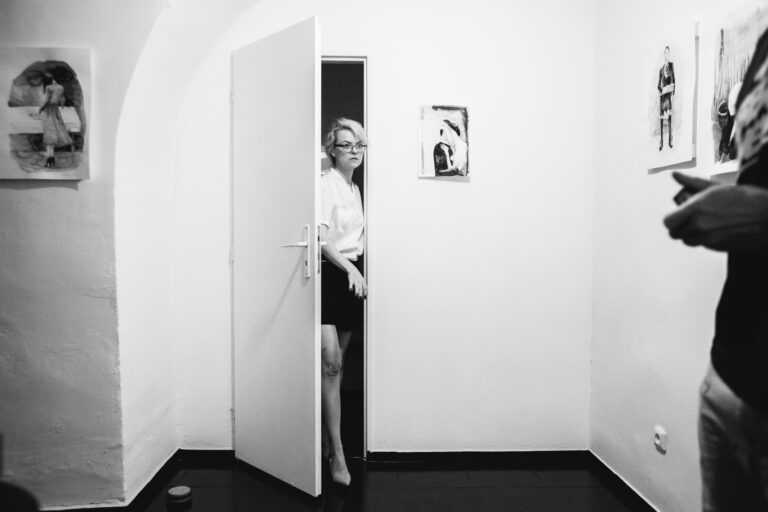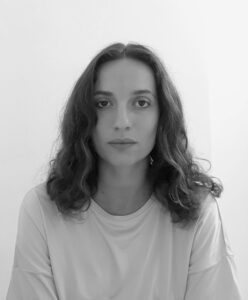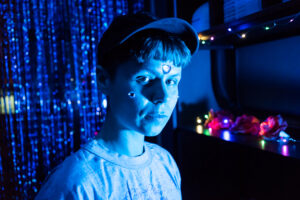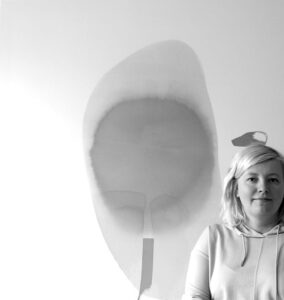Lucia Dovičáková

– born 1981. She is a graduate of Rudolf Sikora’s contemporary painting studio at the Faculty of Arts in Košice. In 2006 she became a finalist in the Oskár Čepan Award, in 2011 she became a laureate of the Tatra Bank Young Creator Award. In 2012 and 2013, she was a finalist in the Painting – VÚB Foundation Award competition. She regularly exhibits in solo and collective exhibitions and her works are present, for example, in the collections of the Slovak National Gallery, the Nedbalka Gallery in Bratislava and other private collections. She lives and works in Košice, Slovakia.
To me, creation means a universe with its own rules, where you do not have to adapt, but where are free. You can play and research. Painting itself is a means of quick expression, where you can create anything, and you only need a minimum of resources. Traditionally, painting depicts a woman as an object of desire and beauty, but I enjoy approaching it subjectively. I like to move in within the frame considered as a good painting, I like to “spoil” it – to look for something in the traditional depiction that touches, evokes emotion, anger … I also like non-academic things, medieval painting and so on, the tension that bad painting presents.
Painting is a relaxation and a challenge for me, it is a moment of silence in which I have space for my own experience. When I devote myself to drawing and watercolour, they represent peace, a certain meditation for me, while in painting I show myself rougher, more passionate, uglier. I work in a diary way and with partial topics, but in the end, it represents a whole. I create because it would be difficult for me to communicate about some things by using other means. The only thing I can understand and get to know is myself, so I do things about myself. And since I am talking about myself, I often use myself as a model. I am interested in the way how to interpret a feeling by minimal means, to express a complicated experience economically. I like to combine symbols; I am also inspired by Freud. I work with several symbols that I use repeatedly – horses1 embody the masculine element for me, desire, id, hair in braids2 embody bond and cutting off, things that you keep, even though they limit you. I am exploring the ideal of a perfect woman in the depiction of a housewife3.
During my studies, I needed to solve “big things” in my work, after school I started to deal with banal scenes from life. For example, I made a series of Madonnas4 that disrupt the idealized depiction of motherhood. They hold a real child in their arms – a raspy, restless, pulling mother’s hair. After the birth of my son, I felt the urge to paint and maintain my world. and also, the fact that I must fight for it. For the time being, I continued to work, which was ultimately reflected in my relationship with the child’s father. A woman is still expected to be very happy to sacrifice and not count on the space for her and her desires and needs.
For me, art is liberation. I am interested in working with an idealized depiction5, beauty without a soul. I am fascinated by the opposites that exist in us – submissiveness and dominance in relationships, the struggle with what we rationally want and what we irrationally desire. I think that the discrepancy between the tensions we feel, and the expectations placed on us is more pronounced for women. These contradictions make me feel that I have not been told the truth. I can unmask it in the painting. It is important for me to realize that women are not ideal and that it is okey. When you encounter such a work, it relieves you that you are not alone, there is a feeling of catharsis from the acknowledgment and acceptance of (also) negative aspects. It is a relief for both the creator and the viewer. My work represents my position and conflict with the world, I capture the idea of who I would like to be versus who I am and who can I be. It is intimate and I like to let it to resonate. I came to this approach intuitively, inspired by reality, I express my thoughts. I do not want to generalize, to teach, rather to point out.
I encounter with disparage that I am a frustrated mother. I feel that Košice, where I live, is still a very conservative and religious city. At the same time, for example, the cult of male genius still prevails at art auctions, which is reflected in the prices and the small number of collectors who collect female authors. I consider myself a feminist. However, I am not an activist and I avoid direct naming, but I gave my work, for example, for a campaign to support the option of an abortion. At the same time, since I use irony and humour, I am often included also in non-feminist exhibitions. I think a lot about why we consider a man’s work to be universal and when a woman´s work is about herself; she is immediately considered a feminist. Why is my truth not universal?
The text was written in collaboration with Michaela Kučová (2021).
1Image: Lucia Dovičáková, Horse. Courtesy of the artist.2Image: Lucia Dovičáková, Sisters. Courtesy of the artist.
3Image: Lucia Dovičáková, Dinner. Courtesy of the artist.
4Image: Lucia Dovičáková, Madonna. Courtesy of the artist.
5Image: Lucia Dovičáková, New Necklace. Courtesy of the artist.
– sa narodila v roku 1981. Je absolventkou ateliéru súčasnej maľby Rudolfa Sikoru na Fakulte umení v Košiciach. V roku 2006 sa stala finalistkou Ceny Oskára Čepana, v roku 2011 sa stala laureátkou ceny Tatra Banky Mladý tvorca. V rokoch 2012 a 2013 bola finalistkou súťaže Maľba – Cena Nadácie VÚB. Pravidelne vystavuje samostatne aj na kolektívnych výstavách a jej diela sú zastúpené napríklad v zbierkach SNG, Galérie Nedbalka a ďalších súkromných zbierkach. Žije a pôsobí v Košiciach.
Tvorba pre mňa predstavuje vesmír s vlastnými pravidlami, kde sa nemusíš prispôsobovať, ale si slobodná. Hráš sa a skúmaš. Samotná maľba je pre mňa prostriedkom rýchleho vyjadrenia, kde môžeš vytvoriť čokoľvek a stačí ti k tomu minimum prostriedkov. Tradične maľba zachytáva ženu ako objekt túžby a krásy, mňa baví k tomu pristupovať subjektívne. Rada sa pohybujem v tom, čo je dobrá maľba, baví ma to „kaziť“ – v tradičnom zobrazení hľadať niečo, čo sa dotkne, vyvolá emóciu, hnev… Páčia sa mi aj neakademické veci, stredoveká maľba a podobne, napätie, ktoré predstavuje bad painting.
Maľovanie je pre mňa relaxom aj výzvou, je to moment stíšenia v ktorom mám priestor pre vlastné prežívanie. Keď sa venujem kresbe a akvarelu, predstavujú pre mňa pokoj, istú meditáciu, kým pri maľbe sa prejavujem hrubšie, vášnivejšie, škaredšie. Pracujem denníkovým spôsobom a s čiastkovými témami, no nakoniec to asi vyznieva celistvo. Tvorím, lebo by sa mi o niektorých veciach ťažko komunikovalo inými prostriedkami. Jediná vec, ktorú dokážem pochopiť a prežiť, som ja sama, preto robím veci o sebe. A keďže hovorím o sebe, často využívam aj seba ako modelku. Zaujíma ma, ako tlmočiť nejaký pocit minimálnymi prostriedkami, komplikované prežívanie vyjadriť úsporne. Baví ma kombinovať symboly, inšpiruje ma aj Freud. Pracujem s viacerými symbolmi, ktoré používam opakovane – kone1 pre mňa zosobňujú mužský element, túžbu, id, vlasy vo vrkočoch2 zas puto a odstrihnutie, veci, ktoré si ponechávaš, napriek tomu, že ťa obmedzujú. Ideál dokonalej ženy skúmam v zobrazení housewife3 – domácich gazdiniek.
Počas štúdia som mala potrebu riešiť vo svojej tvorbe „veľké veci“, po škole som sa začala venovať banálnym výjavom zo života. Spravila som napríklad sériu madon4, ktoré narúšajú idealizované zobrazenie materstva a v náruči držia reálne dieťa – driapajúce, neposedné, ťahajúce matku za vlasy. Po narodení syna som cítila potrebu maľovať a udržať si svoj svet. Aj to, že o to musím bojovať. Zaťato som pracovala ďalej, čo sa nakoniec odrazilo aj na mojom vzťahu s otcom dieťaťa. Od ženy sa stále očakáva, že sa veľmi rada obetuje a neráta sa s priestorom pre ňu a jej túžby a potreby.
Umenie pre mňa predstavuje oslobodenie. Zaujíma ma práca s idealizovaným zobrazením5, krásou bez duše. Fascinujú ma protiklady, ktoré v nás existujú – submisivita a dominancia vo vzťahoch, zápas s tým, čo racionálne chceme a po čom iracionálne túžime. Myslím si, že rozpor medzi pnutiami, ktoré v sebe cítime a očakávaniami, ktoré sú na nás kladené, je u žien vypuklejší. Tieto protiklady vo mne vyvolávajú pocit, že mi nepovedali pravdu. V maľbe to môžem odmaskovávať. Je pre mňa dôležité uvedomenie si žien, že nie sme ideálne a je to tak v poriadku. Pri stretnutí s takýmto dielom ti odľahne, že nie si sama, dochádza k pocitu katarzie z priznania a prijatia (aj) negatívnych aspektov. Je to úľava pre tvorcu aj pre diváka. Moja tvorba predstavuje moja pozíciu a konflikt so svetom, zachytávam predstavu, kým by som chcela byť verzus kým som a môžem byť. Je intímna a som rada, keď rezonuje. Dospela som k tomu intuitívne, inšpirujem sa realitou a vyjadrujem svoje myšlienky. Nechcem zovšeobecňovať, poučovať, skôr poukázať.
Stretávam sa aj so zľahčovaním, že som frustrovaná matka. Cítim, že Košice, kde žijem, sú stále veľmi konzervatívne a náboženstvom formované mesto. Zároveň napríklad aj pri umeleckých aukciách stále prevláda kult mužského génia, čo sa doráža aj na cenách a malom počte zberateľov, ktorí zbierajú ženské autorky. Považujem sa za feministku. Nie som však aktivistka a vyhýbam sa priamemu pomenovaniu, ale poskytla som svoju tvorbu napríklad na kampaň na podporu možnosti ísť na interrupciu. Zároveň vďaka tomu, že používam iróniu a humor, ma zvyknú zaraďovať aj do nefeministických výstav. Veľa uvažujem nad tým, prečo dielo muža považujeme za univerzálne a keď žena robí o sebe, hneď je považovaná za feministku. Prečo moja pravda nie je univerzálna?
Text bol napísaný v spolupráci s Michaelou Kučovou (2021).
1Obrázok: Lucia Dovičáková, Horse. S láskavým dovolením umelkyne.2Obrázok: Lucia Dovičáková, Sisters. S láskavým dovolením umelkyne.
3Obrázok: Lucia Dovičáková, Dinner. S láskavým dovolením umelkyne.
4Obrázok: Lucia Dovičáková, Madonna. S láskavým dovolením umelkyne.
5Obrázok: Lucia Dovičáková, New Necklace. S láskavým dovolením umelkyne.



